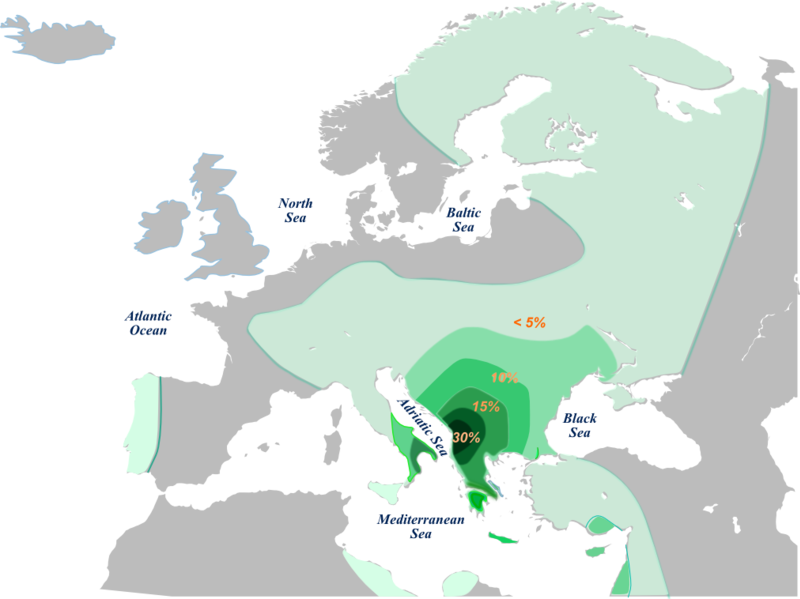B
Besa
Guest
The reason why Croats have so low EV-13, but still exists at 10%? is because Croats and Serbs were invited to the region by the roman empire to fight the avars in the region of Croatia and Bosnia. where i2a peaks.. there they settled. they were given the land... they beat the avars and settled there, and at one point in time asimilated some of the illyrians, thats why bosnians (Serbian muslims) and croats have EV-13 and J2. the Serbian empire asimilated some illyrians and thracians (ev-13 and j2) and also spread i2a, ancestors of albanians fled to the mountains and thats why they have lower i2a and r1a.. where else do you think Albanians came from? Mars? only difference between albanians and neighboring countries is their low i2a and r1a...
r1b might come from celts, romans or something. I don't think proto-albanians fled from romans, because their language is influenced with latin dating back to roman era both western romance and eastern romance. proto-Albanians must of spoken latin a long time but also had their own language, they spoke both latin and greek during the byzantium empire, the jireck line which divided latin in the north and greek in the south, but somehow they still kept their language.. in Kosovo they were under yugoslavia for 100+ years, they read and wrote serbo-croatian, still barely any slavic words. Most of these claimed loan words are not even slavic, and every loan word they have their own words... like hajde is not slavic, its from turkish 'hadi' .. proto-alb: eja ... majmun is also from turkish.. most of their common words with south slavs are from turkish loan words.. but they have their own words for all these loan words. Only thing I can think of that is slavic is maybe ''peder'' and ''kurva'' and you know what that means
I have also mentioned the Albanian-Romanian connection and 300 common words, yet they have lower i2a and r1a than romanians.. Illyrians and thracian-dacians were related people, both carrying haplogroup EV-13 and J2. then came the celts with r1b.
Albanians lived mostly where they live today. trying to connect them with tribes in Dacia and Thracia because of commonwords, I could do the same with in Illyria, like scodra from shkodra, dardania from the alb word dardhe which means pear.... or the tribe scitari (shqiptari) or thunaki (thuj) or delmatae (delme) meaning sheep i could go on and on... old city of dubrovnik: ragusa which meant grape in illyrian: alb:rrush... or city of Ulqin in montenegro.. ulk meant wolf in illyrian, alb: ulk/ujk.. same meaning.... conclusion is illyrians and thracians must of been related and spoken a similar language
r1b might come from celts, romans or something. I don't think proto-albanians fled from romans, because their language is influenced with latin dating back to roman era both western romance and eastern romance. proto-Albanians must of spoken latin a long time but also had their own language, they spoke both latin and greek during the byzantium empire, the jireck line which divided latin in the north and greek in the south, but somehow they still kept their language.. in Kosovo they were under yugoslavia for 100+ years, they read and wrote serbo-croatian, still barely any slavic words. Most of these claimed loan words are not even slavic, and every loan word they have their own words... like hajde is not slavic, its from turkish 'hadi' .. proto-alb: eja ... majmun is also from turkish.. most of their common words with south slavs are from turkish loan words.. but they have their own words for all these loan words. Only thing I can think of that is slavic is maybe ''peder'' and ''kurva'' and you know what that means
I have also mentioned the Albanian-Romanian connection and 300 common words, yet they have lower i2a and r1a than romanians.. Illyrians and thracian-dacians were related people, both carrying haplogroup EV-13 and J2. then came the celts with r1b.
Albanians lived mostly where they live today. trying to connect them with tribes in Dacia and Thracia because of commonwords, I could do the same with in Illyria, like scodra from shkodra, dardania from the alb word dardhe which means pear.... or the tribe scitari (shqiptari) or thunaki (thuj) or delmatae (delme) meaning sheep i could go on and on... old city of dubrovnik: ragusa which meant grape in illyrian: alb:rrush... or city of Ulqin in montenegro.. ulk meant wolf in illyrian, alb: ulk/ujk.. same meaning.... conclusion is illyrians and thracians must of been related and spoken a similar language









